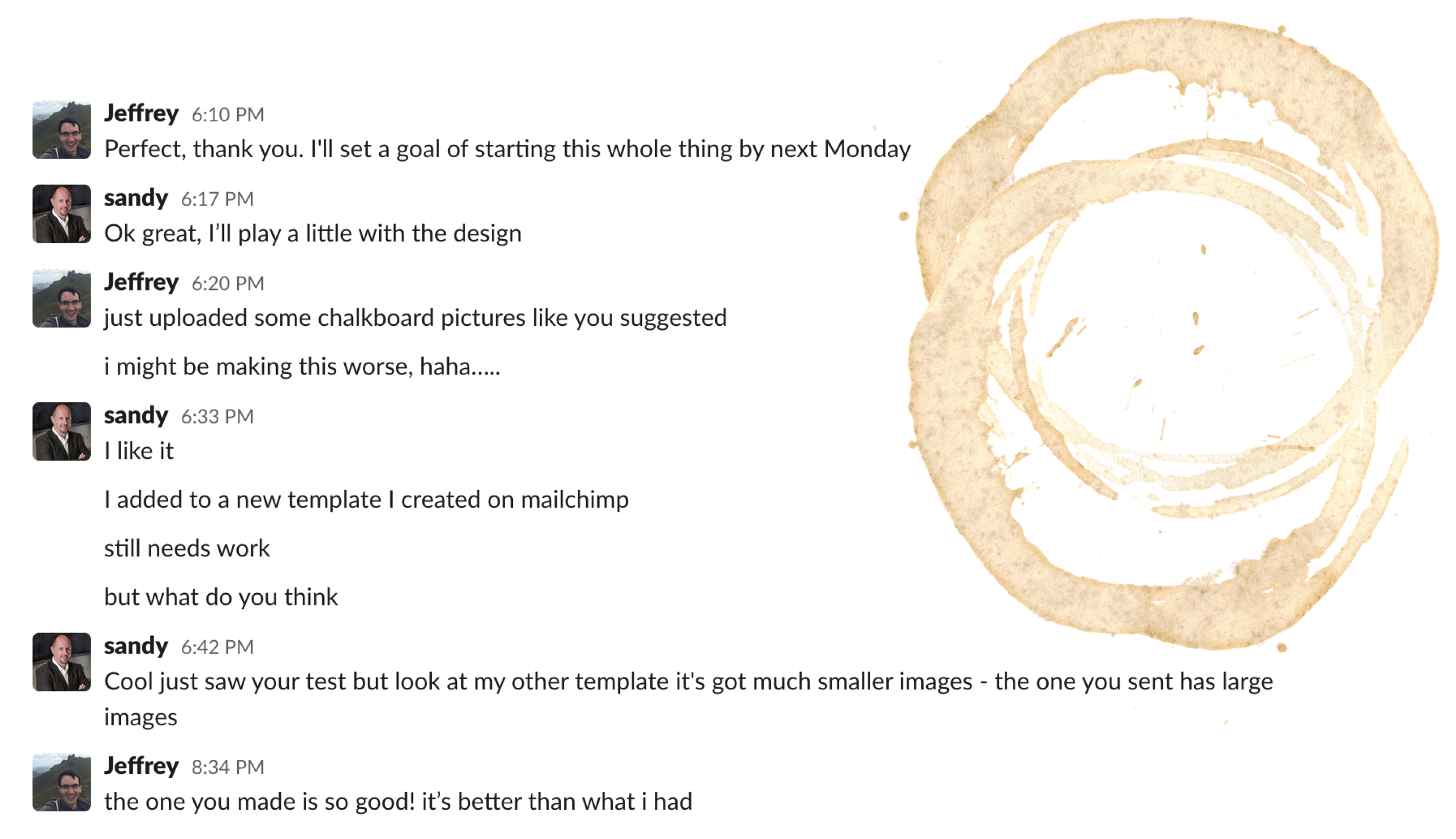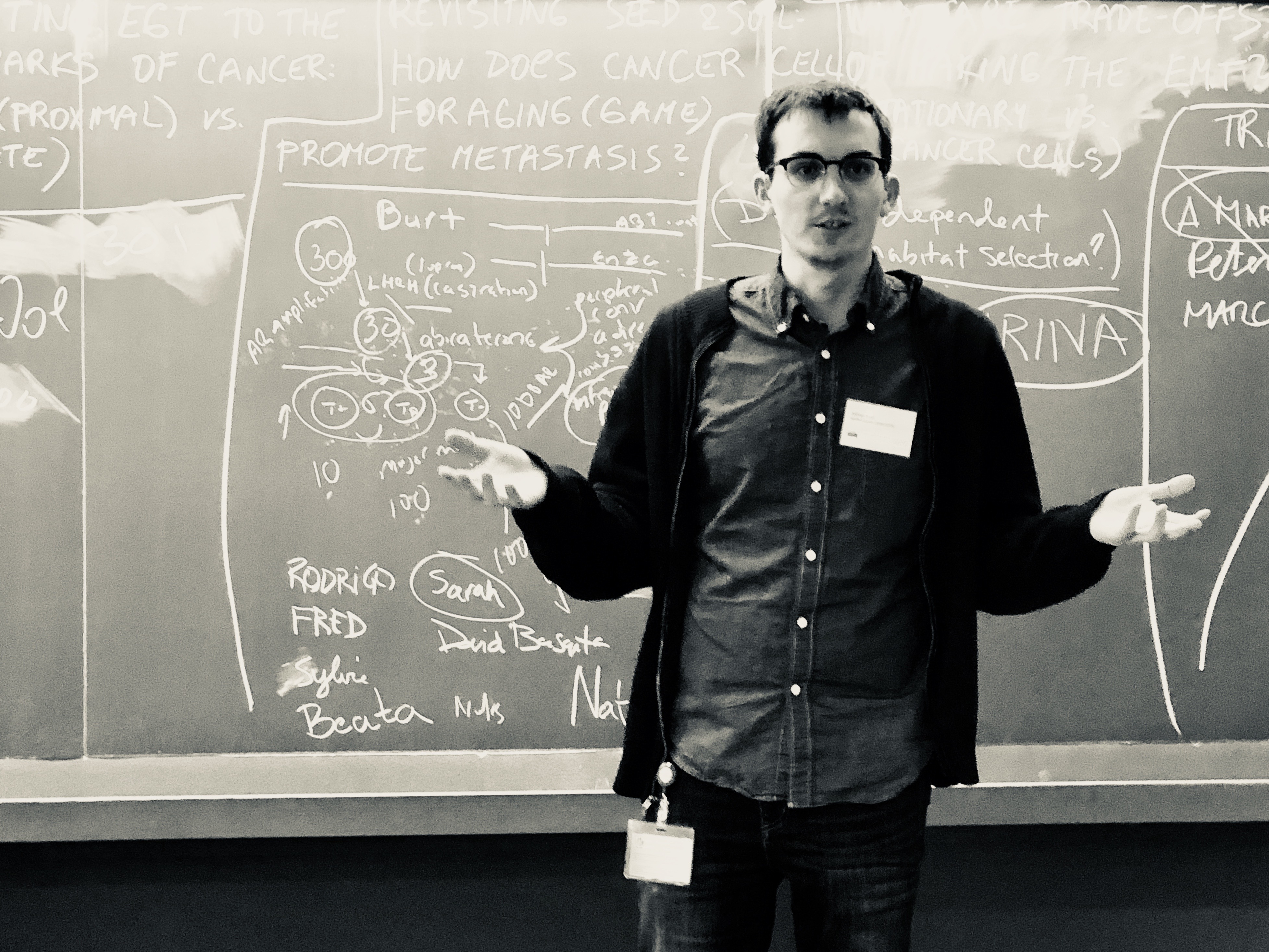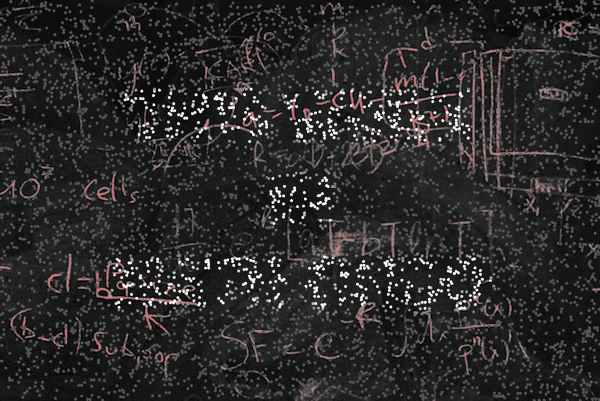The past 185 weeks in MathOnco
The road to 1000 subscribers
 Sandy has always been interested in growing math oncology through community engagement. Past examples include hosting collaborative workshops, blog posts, or even a “board of the week.” So, it made sense to continue the trend of his lab by starting the newsletter.
We drafted the first edition together in December 2017, just 4 months after my start date at Moffitt. Sandy pushed me to consider the design of the letter. This first edition contained section headers which were hand-written in chalk on the boards of the IMO Collaboratorium. The chalkboard aesthetic continues today (no whiteboards for us…).
Sandy has always been interested in growing math oncology through community engagement. Past examples include hosting collaborative workshops, blog posts, or even a “board of the week.” So, it made sense to continue the trend of his lab by starting the newsletter.
We drafted the first edition together in December 2017, just 4 months after my start date at Moffitt. Sandy pushed me to consider the design of the letter. This first edition contained section headers which were hand-written in chalk on the boards of the IMO Collaboratorium. The chalkboard aesthetic continues today (no whiteboards for us…).

The curation process
My process looks like this: each week I save articles that I came across on Twitter, Biorxiv (or arXiv) alerts, and emails from colleagues. I save everything that I come across in my Pocket app. Then, once a week I comb through Pocket to determine if articles have two components: at least one equation (“math”) and some application to cancer (“onco”). The application may be fairly loose: I do include articles on evolution, ecology, game theory, agent-based modeling, or computational tools with broader application than cancer. I also like to post recent review articles. I find that reviews (e.g. Nature Reviews Cancer or Perspective pieces) are the most likely to be opened. Many of the newsletter readers have a math background, so reviews provide a nice foundational understanding of the biology of cancer.What is MathOnco?
My curation process is minimal: I would rather the field to be aware of all recent work rather than try to serve as the final arbiter of math oncology. In a way, a weekly newsletter is easier than a monthly newsletter. Careful monthly curation would require massive effort to distill and pare down to the best papers each month. Instead, isn’t that the job of every scientist? To read widely and determine fruitful directions of research? However, I don’t include everything. Included papers could be categorized as math oncology, or more broadly: computational or systems biology. The lines are blurred. What is considered math oncology? I rarely include machine learning applications to cancer or bioinformatics papers with no first-principles model of some aspect of cancer. Perhaps math oncology needs to make a greater effort to bridge some of these disciplines?Quick Statistics
This week in MathOnco:- ~1000 subscribers
- ~25 countries
- ~40% open rate
- ~5 new subs/week
- 170 issues in 185 weeks (since December 2017)
 Altmetric is a service which tags each publication with news alerts, Tweets, Facebook posts, and blog posts. By registering “This week in MathOnco” with Altmetric, each publication now receives the coveted yellow stripe in its Altmetric badge (and +7 on its Altmetric score).
We all know that Twitter popularity doesn’t always correlate with truly impactful science, and that Altmetric scores are not the final word. But I’m still proud of adding Altmetric to the blog for the following reason: authors receive a ping from Altmetric with the implication that “the field of math oncology is interested in your research.”
Many journals now feature the Altmetric badge on the home page, enabling people to stumble upon the newsletter when they see their article featured. This is very common, and often one of the highest sources of traffic (typically second only to Twitter).
These new connections are helpful for community growth. Being featured in the newsletter gives others an indication that math oncology is an emerging, growing field. Hopefully this small indication can lead to new collaborations, better science. It gives everyone a sense of who is publishing relevant papers, and who to suggest to review your own papers.
Altmetric is a service which tags each publication with news alerts, Tweets, Facebook posts, and blog posts. By registering “This week in MathOnco” with Altmetric, each publication now receives the coveted yellow stripe in its Altmetric badge (and +7 on its Altmetric score).
We all know that Twitter popularity doesn’t always correlate with truly impactful science, and that Altmetric scores are not the final word. But I’m still proud of adding Altmetric to the blog for the following reason: authors receive a ping from Altmetric with the implication that “the field of math oncology is interested in your research.”
Many journals now feature the Altmetric badge on the home page, enabling people to stumble upon the newsletter when they see their article featured. This is very common, and often one of the highest sources of traffic (typically second only to Twitter).
These new connections are helpful for community growth. Being featured in the newsletter gives others an indication that math oncology is an emerging, growing field. Hopefully this small indication can lead to new collaborations, better science. It gives everyone a sense of who is publishing relevant papers, and who to suggest to review your own papers.
Behind the scenes
Honestly, I would continue to do this if no one read it. The personal benefit has been huge. I am aware of a vast quantity of research in the field (at the very least superficially). I now have a basic understanding of where this science tends to get published. This helps me craft good titles for my own papers (and to know where to submit them!). I’ve also met so many wonderful colleagues. I get to support and highlight great science, facilitating the growth of math oncology. It’s all very rewarding. Today, the work is more self-sustaining than ever. There are the MathOnco faithful who email me their newly minted publications (or tag me on Twitter). You know who you are. Thank you!Newsletters for science
Substack newsletters aren’t going away any time soon. It marries the two strengths of blogs and email. The greatest strength of email is persistence: emails do not go away until the user deletes them. The greatest strength of blogs is a dedicated home page with a back-catalogue of previous posts. Substack has both. Substack has a dedicated science section. I was recently interviewed by a sociologist from Harvard who is studying the impact of Substack newsletters in science and academia. With the explosion of publications and preprints that is still seemingly expanding, services which help distill the information overload into bite-sized chunks is valuable.Hidden artists
In many ways, math biology has always overlapped with artistic design. Is it because the math bio community sees the beauty in both numbers and nature? Whatever the reason, Sandy and I were excited to ask Maximilian Strobl to help solicit cover artwork for the newsletter. The fact that so many of our readers were willing to dedicate some free time to designing a cover means a lot to me. I am enjoying seeing the hidden artists pop up every week. Below are some examples:
Issue 160: submitted by David A. Hormuth, II, submitted in conjunction with a recent publication. Caption: In our recent efforts to translate our pre-clinical models of glioma growth and response to the clinical setting we employed multiparametric MRI collected before and after radiation therapy to initialize and parameterize our model of tumor growth and response. Anatomical imaging was used to estimate the tumor burden, while diffusion weighted imaging was applied to estimate cell density. We then applied our modeling framework to forecast response to chemoradiation for each patient and overlaid the predicted distribution of tumor cells on anatomical images. This effort was a collaboration between the Oden Institute (Hormuth and Yankeelov) and the M.D. Anderson Cancer Center (Al Feghali, Elliott, and Chung).

Issue 162: submitted by Xiaoran Lai and Alvaro Köhn-Luque, submitted in conjunction with their recent preprint, found here. Caption: Patient-specific outcome after a single chemotherapy shot in a heterogenous breast tumour. Simulated using a parallel solver of a stochastic, hybrid cellular automata. Background colors indicate oxygen pressure in the tumor tissue while cancer cells are represented by black dots.

Issue 166: submitted by Saskia Haupt and Alexander Zeilmann, submitted in conjunction with their recent publication. Caption: Caption: Colorectal cancer usually develops from normal mucosa over precursor lesions to a carcinoma which can be analyzed using a histopathological section (from bottom to top, left part of figure). We developed a mathematical model to describe this process, including multiple pathways of carcinogenesis, with ordinary differential equations and the Kronecker structure (right part of figure). This specific matrix structure is the key to our paper. It allows for detailed mathematical analysis, low computational costs and medical interpretability.
To celebrate the occasion of 1000 subscribers, we've put together some of our own artwork and made it available for purchase. Check out the store here to buy a MathOnco t-shirt or coffee mug.
Artwork Credit: thanks Jill Gallaher, Maxi Strobl, Sandy Anderson, and Chandler Gatenbee!
The final word
My biggest regret: I should’ve named it “Last week in MathOnco”. I think about this weekly. 🤣© 2025 - The Mathematical Oncology Blog